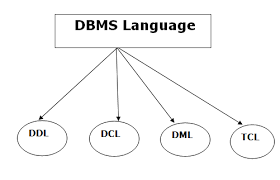DBMS is an interface between the end user and the database. Also, managing the data, the database engine, and the database schema in order to facilitate the organization and manipulation of data.
DATABASE LANGUAGES are used to read, update and store data in a database. There are several such languages that can be used for this purpose; one of them is SQL (Structured Query Language).
There are Basically 4 Types of DBMS database languages:
Data Definition Languages (DDL)
Data Manipulation Languages (DML)
Data Control Languages (DCL)
Transaction Control Languages (TCL)
DATA DEGINITION LANGUAGES
Data Definition Language (DDL) statements are used to classify the database structure or schema. It is a type of language that allows the DBA or user to depict and name those entities, attributes, and relationships that are required for the application along with any associated integrity and security constraints. Here are the lists of tasks that come under DDL:
CREATE - used to create objects in the database
ALTER - used to alters the structure of the database
DROP - used to delete objects from the database
TRUNCATE - used to remove all records from a table, including all spaces allocated for the records are removed
COMMENT - used to add comments to the data dictionary
RENAME - used to rename an object
Data Manipulation Language
A language that offers a set of operations to support the fundamental data manipulation operations on the data held in the database. Data Manipulation Language (DML) statements are used to manage data within schema objects. Here are the lists of tasks that come under DML:
SELECT - It retrieves data from a database
INSERT - It inserts data into a table
UPDATE - It updates existing data within a table
DELETE - It deletes all records from a table, the space for the records remain
MERGE - UPSERT operation (insert or update)
CALL - It calls a PL/SQL or Java subprogram
EXPLAIN PLAN - It explains the access path to data
LOCK TABLE - It controls concurrency
Data Control Language
There are two other forms of database sub-languages. The Data Control Language (DCL) is used to control privilege in Databases. To perform any operation in the database, such as for creating tables, sequences, or views, we need privileges. Privileges are of two types,
System - creating a session, table, etc. are all types of system privilege.
Object - any command or query to work on tables comes under object privilege. DCL is used to define two commands. These are:
Grant - It gives user access privileges to a database.
Revoke - It takes back permissions from the user.
Transaction Control Language (TCL)
Transaction Control statements are used to run the changes made by DML statements. It allows statements to be grouped into logical transactions.
COMMIT - It saves the work done
SAVEPOINT - It identifies a point in a transaction to which you can later roll back
ROLLBACK - It restores the database to original since the last COMMIT
SET TRANSACTION - It changes the transaction options like isolation level and what rollback segment to use
Sofia Sondh
The Tech Platform

